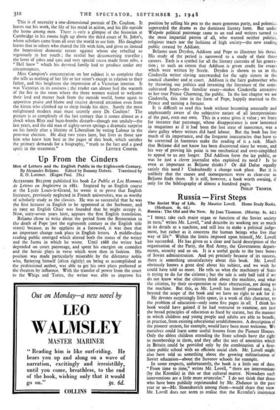Up From the Cinders
Men of Letters and the English Public in the Eighteenth Century. By Alexandre Beljame. Edited by Bonamy Dobree. Translated by E. 0. Lorimer. (Kegan Paul. 25s.)
ALEXANDRE BELJAME published his book Le Public et Les Hammes de Lettres en Angleterre in i881. Inspired by an English course at the Lycee Louis-le-Grand, he wrote it to prove that English literature, previously neglected in French universities, was as worthy of scholarly study as the classics. He was so successful that he was the first lecturer in English to be appointed at the Sorbonne, and in 1902 an English Chair was founded that he might occupy it. Now, sixty-seven years later, appears the first English translation.
Beljame chose to write about the period from the Restoration to the death of Pope (not the eighteenth century as the English title states) because, as he e2Eplains in . a foreword, it was then that an important change took place in English letters. A middle-class reading public emerged which altered both the status of the writer and the forms in which he wrote. Until 1688 the writer had depended on court patronage, and spent his energies on comedies and the heroic plays in verse which were then in fashion. His position was made particularly miserable by the dilettante noble who, flattering himself (often rightly) on being as accomplished as the professional author, was able to get his own plays preferred at the theatres by influence. With the transfer of power from the court to the Whigs and Tories, the writer was able to improve his
position by selling his pen to the more generous party, and polemics superseded the drama as the dominant literary form. But under Walpole political patronage came to an end and writers turned to the most impartial patron of all, who wanted neither politics, religious tracts nor the fashions of high society—the new reading public created by Addison.
Beljame uses Dryden, Addison and Pope to illustrate his thesis. His study of the period is narrowed to a study of their three careers. Each is a symbol for all the literary currents of his genera- tion; to such an extent that Addison is given credit for essays which were written by Steele. Dryden is shown to us as the Cinderella writer slaving unrewarded for the ugly sisters in the council chamber and at court. Addison is the fairy godmother who by throwing out politics and inventing the literature of the semi- cultivated heart—the familiar essay—makes Cinderella attractive to her true Prince Charming, the public. In the last chapter we see Cinderella, this time in the form of Pope, happily married to the Prince and earning a fortune.
It is difficult to read this book without becoming unusually and unpleasantly aware of the subjective nature of all interpretations of the past, even our own. This in a sense gives it value ; we learn for instance that patronage whose disappearance is now lamented in magazines as if it had been the lost state of innocence, was a slave galley where writers did hard labour. But the book has lost much of its importance, and the frequent inaccuracies that have to be corrected in footnotes make the reading of it a task. Much that Beljame did not know has been discovered since he wrote, and his way of proving his point is too mechanical and over-simplified to appeal to us any longer. Did Addison form the lay public, or was he just a clever journalist who exploited its need ? Is he even as important as Beljame thinks ? Or did Defoe equally satisfy this need ? Undoubtedly a change took place. But it is unlikely that the causes and consequences were as clear-cut as l3eljame finds them. It is still, however, a book worth owning, if only for the bibliography of almost a hundred pages.
PHILIP TROWEL


































 Previous page
Previous page